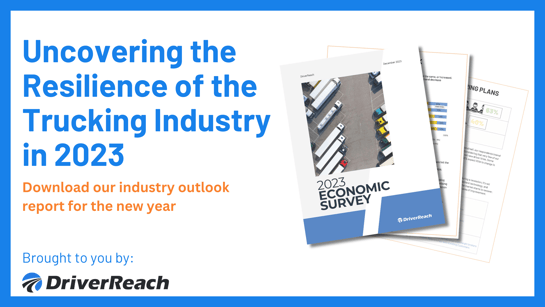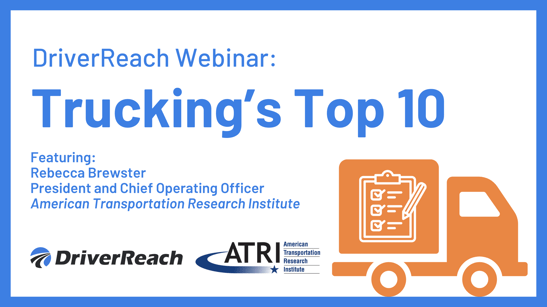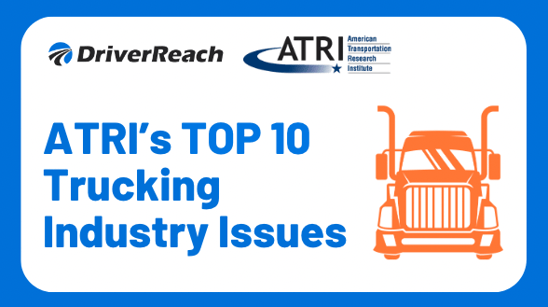Did you have a chance to attend our recent webinar, Roadmap to Recovery: Navigating Trucking's Economic Future with Bob Costello? We addressed and received a variety of questions during this event, so our guest, Bob Costello, Chief Economist and Senior Vice President of the American Trucking Associations, answered them below in this Q&A-style blog post for anyone who missed it.
If you couldn’t join the live webinar, don’t worry – you can watch it on-demand anytime!
Question: You talked earlier about the impact of inventory levels on the economy—they’ve been high and acted as a headwind on freight. How long will it take for retailers to work through their inventory?
Answer: They're getting pretty close, I think. Retailers are right there on the edge; they have been chipping away at that inventory pile for a good while now. But don't go expecting them to start restocking in a hurry; that's not on the horizon. It's the wholesale side that's throwing a bit of a curveball. Yeah, wholesale inventories have been inching up, and that's a bit of a setback.
So, the deal is, this could maybe help the flow of freight from the wholesalers to the retailers, which wasn't exactly happening before. But let's not kid ourselves, we're not in for some freight explosion just because retailers suddenly decide they need to stock up like crazy. You won't see them all rushing to import heaps of goods from Asia or anything.
That's partly why those port numbers on the West Coast, they're not exactly off the charts. Without that restocking frenzy, things are looking a bit mellow there. But hey, back to the retailers, they're making some headway. The destocking game is getting closer to the final round, and some players might have already wrapped it up.
Now, when it comes to wholesale inventories, I can't help but feel a tad uneasy. They might not be in a terrible state, but you can bet I'll be keeping a close eye on that action.
Question: Are there potential implications for China, like the possibility of a recession? Although we didn't extensively discuss this, you did mention the impact on ports, particularly on the West Coast. Could this somehow tie into the ongoing situation in China? I've been hearing some discussions about China facing challenges – is there validity to these claims?
Answer: China really has some issues, right? There's a lot of real estate things. They were going through this unbelievable building mode. But here's the thing I've been saying all along: Every economy, even those run by communist governments, boils down to two main factors for long-term growth—productivity and population growth.
The one-child policy in China, it was a colossal failure. Right? Now, and that's gonna slow down. they have way too many older people and they don’t have enough young people. They’re going to have to resort to a lot of immigration to try to resolve that problem.
We're not doing fantastic either, but we're not in China's shoes. It could be worse; imagine being Japan or Italy, where their population is actually shrinking. I don’t know how you grow an economy with a shrinking population.
But, again, our growth has slowed too. Back in the early 1990s, we were chugging along at 1.5% population growth per year. Now? We're barely hitting 0.5%, and that's even after you take out the horrible losses we saw during the pandemic. So, it means we've got to get a lot more productive to maintain our long-run average.
I ran some numbers. If we follow the trend from 2000 to 2015 in our working-age population, we should be sitting on 11 million more workers than we actually have now. You won't believe it, but we've got less than 6 million folks unemployed across the country.
Now, China's got it worse, no doubt about it. They're growing faster than us, sure. But guess what? Their population's growth engine isn't what it used to be. Tough times ahead for them, I'd say. They're in for a ride because their population isn't growing like it once was.
Question: You mentioned travel as an economic factor. Is there a concern people have used much of their savings for travel and goods and spending could slow?
Answer: Absolutely, spending is definitely expected to slow down. If you take a look at my initial GDP slide, you'll see that the growth rate is shifting. We went from a 2.1% growth last year to a projected 2.2% growth this year, but then we're looking at a drop to 1.4% and 1.3% in the subsequent years—2024 and 2025. So, without a doubt, the pace of spending is on a downward trajectory.
The change we're witnessing isn't entirely unexpected, especially given that a significant portion of the spending spree has already occurred, particularly in the realm of goods. Now, I anticipate that spending on services will also taper off, but it won't stagnate suddenly. It's just that the rate of growth will settle into a more typical pattern, a reversion to the mean, so to speak.
So, it's safe to say that we're looking at a slowdown in spending over the next couple of years. This transition is quite in line with the overall economic trends we're observing.
Question: At what point did we come to realize that a 0% rate is not sustainable? With the ongoing concerns about interest rates, including the potential for additional hikes followed by a hold, it's been a subject of discussion for around 6 to 7 years before the rates were actually increased. Are the ongoing interest rate hikes an attempt to correct for previous inaction and restore balance, considering the recognition that a 0% interest rate is not sustainable
Answer: Sure thing. The Fed's interest rate moves are a bit of a balancing act. People might look back and say, "Hey, why didn't we start earlier?" But it's a tough call. Right now, the Fed funds rate, the rate they use to guide monetary policy, stands at 5.25% and a quarter percent, and they might nudge it up to 5.5% down the line, maybe after their meeting in October.
Now, even if they make that move, I'd wager they're going to stop there. It's not like they're going to hit reverse and start lowering rates anytime soon. And even if we hit a minor recession, I'd still bet against a rate decrease.
See, the thing is, interest rates were hanging around near zero for over a decade. And that messes with how an economy's supposed to work. The Fed, they want it more around 5%, so maybe they overshoot it a little bit so they can get back a little bit if they have to.
What's interesting is that not everyone feels these rate hikes the same way. Less than 15% of consumer debt—household debt— is variable rate. So, if you haven't been out buying cars or houses lately, this might not hit you all that much. Actually, some folks might be benefiting because their interest-bearing accounts are earning more. And for those who've got fixed-rate loans, well, they're not seeing any change.
Keep in mind, raising interest rates is like using a hammer to fine-tune a watch – it's not the most precise tool. The Fed's got this challenge where not everyone's impacted the same way. Not all investments respond uniformly to these hikes. It's not just about loans but also about returns on investments, whether equities or fixed income.
So, you see, the Fed's trying to find that sweet spot. They're moving away from the prolonged near-zero rates we got used to, and yeah, while it might not hit everyone equally, it's their way of getting the economy back in shape.
Question: What is happening in the banking environment for borrowers? If cash flow is slow or negative and many companies are stuck with new and used equipment they can no longer pay for… Will banks adjust, or will they push companies to liquidate?
Answer: I can't speak directly for the banks, but based on conversations with finance companies, there seems to be a trend. Smaller fleets and independent contractors who are missing or skipping payments altogether face some tough consequences. These finance companies are starting to take action and shutting down these businesses.
This situation isn't doing any favors for the value of used equipment. It's been anticipated, though. The finance industry has been waiting to see how things unfold. On a related note, even insurance providers are noticing a pattern. When they inquire about businesses not renewing their insurance, a common reason is that many are going out of business.
It circles back to operational efficiency – or the lack of it. This is a challenging period, and businesses, including trucking companies, are realizing the need to tighten up their operations and run as efficiently as possible. It's not just the trucking industry; this applies across the board. No matter the sector, optimizing capital usage is critical in times like these.
Question: Rising cost of diesel. What is driving this trend, and how will it impact the industry and the broader economic landscape
Answer: Absolutely, rising diesel prices are a real concern on the horizon. Just last week, I think they shot up by about 8 cents per gallon, if I recall correctly. Now, they're not quite at the peak we've seen before – the peak that came after they had been dropping for a good while. But let's face it, this trend could be trouble, especially for those smaller trucking outfits working the spot market.
And it's not just the truckers who feel it; higher diesel costs mean higher operational expenses for everyone, businesses across the board. There's a mix of reasons behind this surge. From the ongoing turmoil in Ukraine to some refinery issues cropping up during the late summer period.
For these trucking folks, especially the ones already juggling tight budgets, this surge in diesel prices, it's not going to be easy to handle. Remember how a dip in diesel prices last spring kind of saved the day for some of them? This could be the catalyst that causes some of them to go out.






